Social Determinants of Health and 30-Day Readmission for Heart Failure Patients in U.S. Hospitals: Evidence from ICD-10 Z-Code Data
Abstract
1. Introduction
2. Methods
2.1. Data Source
2.2. Hospital and Patient Eligibility and Selection
2.3. Statistical Analysis
3. Results
3.1. Baseline Characteristics
3.2. Chi-Square Association Test
3.3. SDoH Adjusted Odds Ratios
3.4. Association Between All SDoH Sub-Z-Codes and Readmission
3.5. Association Between the Number of SDoH Codes and Readmission
4. Discussion
4.1. Pathway and Intervention
Limitations
5. Conclusions
Supplementary Materials
Author Contributions
Funding
Conflicts of Interest
References
- Jiang, H.J.; Barrett, M.L. Clinical conditions with frequent, costly hospital readmissions by payer, 2020. In Healthcare Cost and Utilization Project (HCUP) Statistical Briefs; Agency for Healthcare Research and Quality: Rockville, MD, USA, 2024; p. 307. Available online: https://hcup-us.ahrq.gov/reports/statbriefs/sb307-readmissions-2020.jsp (accessed on 16 July 2025).
- Rizzuto, N.; Charles, G.; Knobf, M.T. Decreasing 30-day readmission rates in patients with heart failure. Crit. Care Nurse 2022, 42, 13–19. [Google Scholar] [CrossRef]
- More Hospitals Brace for Readmission Penalties in 2024. Available online: https://www.advisory.com/daily-briefing/2023/09/18/readmission-penalties (accessed on 16 July 2025).
- Alvarado, M.; Lahijanian, B.; Zhang, Y.; Lawley, M. Penalty and incentive modeling for hospital readmission reduction. Oper. Res. Health Care 2023, 36, 100376. [Google Scholar] [CrossRef]
- Ghabowen, I.K.; Patien Epané, J.; Cochran, C.; Dingley, C.; Shen, J.; Goodman, X. Reducing readmissions: A business case for US hospitals. Qual. Manag. J. 2024, 31, 242–252. [Google Scholar] [CrossRef]
- Liu, S.; Graves, N.; Ma, C.; Pan, J.; Xie, Y.; Lee, S.Y.; Senanayake, S.; Kularatna, S. Preventability of readmissions for patients with heart failure—A scoping review. Heart Lung 2025, 71, 81–89. [Google Scholar] [CrossRef] [PubMed]
- Krumholz, H.M.; Chaudhry, S.I.; Spertus, J.A.; Mattera, J.A.; Hodshon, B.; Herrin, J. Do non-clinical factors improve prediction of readmission risk? results from the Tele-HF study. JACC Heart Fail. 2016, 4, 12–20. [Google Scholar] [CrossRef]
- Marzinski, S.; Melrose, D.; Moynihan, T.; Hlebichuk, J.; Liao, Y.; Hook, M. Knowing the patient: Understanding readmission reasons in complex heart failure. J. Cardiovasc. Nurs. 2024, 39, 438–448. [Google Scholar] [CrossRef]
- Evans, W.N.; Kroeger, S.; Munnich, E.L.; Ortuzar, G.; Wagner, K.L. Reducing readmissions by addressing the social determinants of health. Am. J. Health Econ. 2021, 7, 1–40. [Google Scholar] [CrossRef]
- Browder, S.E.; Rosamond, W.D. Preventing heart failure readmission in patients with low socioeconomic position. Curr. Cardiol. Rep. 2023, 25, 1535–1542. [Google Scholar] [CrossRef] [PubMed]
- Pendyal, A.; Rosenthal, M.S.; Spatz, E.S.; Cunningham, A.; Bliesener, D.; Keene, D.E. “When you’re homeless, they look down on you”: A qualitative, community-based study of homeless individuals with heart failure. Heart Lung 2021, 50, 80–85. [Google Scholar] [CrossRef]
- Doran, K.M.; Ragins, K.T.; Iacomacci, A.L.; Cunningham, A.; Jubanyik, K.J.; Jenq, G.Y. The revolving hospital door: Hospital readmissions among patients who are homeless. Med. Care 2013, 51, 767–773. [Google Scholar] [CrossRef]
- Gorji, M.H.; Fatahian, A.; Farsavian, A. The impact of perceived and objective social isolation on hospital readmission in patients with heart failure: A systematic review and meta-analysis of observational studies. Gen. Hosp. Psychiatry 2019, 60, 27–36. [Google Scholar] [CrossRef]
- Jujo, K.; Kagiyama, N.; Saito, K.; Kamiya, K.; Saito, H.; Ogasahara, Y.; Maekawa, E.; Konishi, M.; Kitai, T.; Iwata, K.; et al. Impact of social frailty in hospitalized elderly patients with heart failure: A FRAGILE-HF registry subanalysis. J. Am. Heart Assoc. 2021, 10, e019954. [Google Scholar] [CrossRef] [PubMed]
- White-Williams, C.; Rossi, L.P.; Bittner, V.A.; Driscoll, A.; Durant, R.W.; Granger, B.B.; Graven, L.J.; Kitko, L.; Newlin, K.; Shirey, M.; et al. Addressing social determinants of health in the care of patients with heart failure: A scientific statement from the American Heart Association. Circulation 2020, 141, e841–e863. [Google Scholar] [CrossRef] [PubMed]
- Calvillo–King, L.; Arnold, D.; Eubank, K.J.; Lo, M.; Yunyongying, P.; Stieglitz, H.; Halm, E.A. Impact of social factors on risk of readmission or mortality in pneumonia and heart failure: Systematic review. J. Gen. Intern. Med. 2013, 28, 269–282. [Google Scholar] [CrossRef]
- ICD—ICD-10-CM—International Classification of Diseases, Tenth Revision, Clinical Modification. Available online: https://www.cdc.gov/nchs/icd/icd-10-cm/index.html (accessed on 16 July 2025).
- Resource on ICD-10-CM Coding for Social Determinants of Health | AHA. Available online: https://www.aha.org/dataset/2018-04-10-resource-icd-10-cm-coding-social-determinants-health (accessed on 14 May 2021).
- Standardizing Social Determinants of Health Assessments | Health Affairs Blog. Available online: https://www.healthaffairs.org/do/10.1377/hblog20190311.823116/full/ (accessed on 11 May 2021).
- McHugh, M.L. The chi-square test of independence. Biochem. Med. 2013, 23, 143–149. [Google Scholar] [CrossRef]
- Heidari, E.; Zalmai, R.; Richards, K.; Sakthisivabalan, L.; Brown, C. Z-code documentation to identify social determinants of health among Medicaid beneficiaries. Res. Soc. Adm. Pharm. 2023, 19, 180–183. [Google Scholar] [CrossRef] [PubMed]
- Braveman, P.; Gottlieb, L. The social determinants of health: It’s time to consider the causes of the causes. Public Health Rep. 2014, 129, 19–31. [Google Scholar] [CrossRef]
- Hill-Briggs, F.; Adler, N.E.; Berkowitz, S.A.; Chin, M.H.; Gary-Webb, T.L.; Navas-Acien, A.; Haire-Joshu, D. Social determinants of health and diabetes: A scientific review. Diabetes care 2020, 44, 258. [Google Scholar] [CrossRef]
- Rodríguez-Artalejo, F.; Guallar-Castillón, P.; Herrera, M.C.; Otero, C.M.; Chiva, M.O.; Ochoa, C.C.; Banegas, J.R.; Pascual, C.R. Social network as a predictor of hospital readmission and mortality among older patients with heart failure. J. Card. Fail. 2006, 12, 621–627. [Google Scholar] [CrossRef]
- Sterling, M.R.; Ringel, J.B.; Pinheiro, L.C.; Safford, M.M.; Levitan, E.B.; Phillips, E.; Brown, T.M.; Goyal, P. Social determinants of health and 90-day mortality after hospitalization for heart failure in the REGARDS study. J. Am. Heart Assoc. 2020, 9, e014836. [Google Scholar] [CrossRef]
- Gottlieb, L.; Tobey, R.; Cantor, J.; Hessler, D.; Adler, N.E. Integrating social and medical data to improve population health: Opportunities and barriers. Health Aff. 2016, 35, 2116–2123. [Google Scholar] [CrossRef] [PubMed]

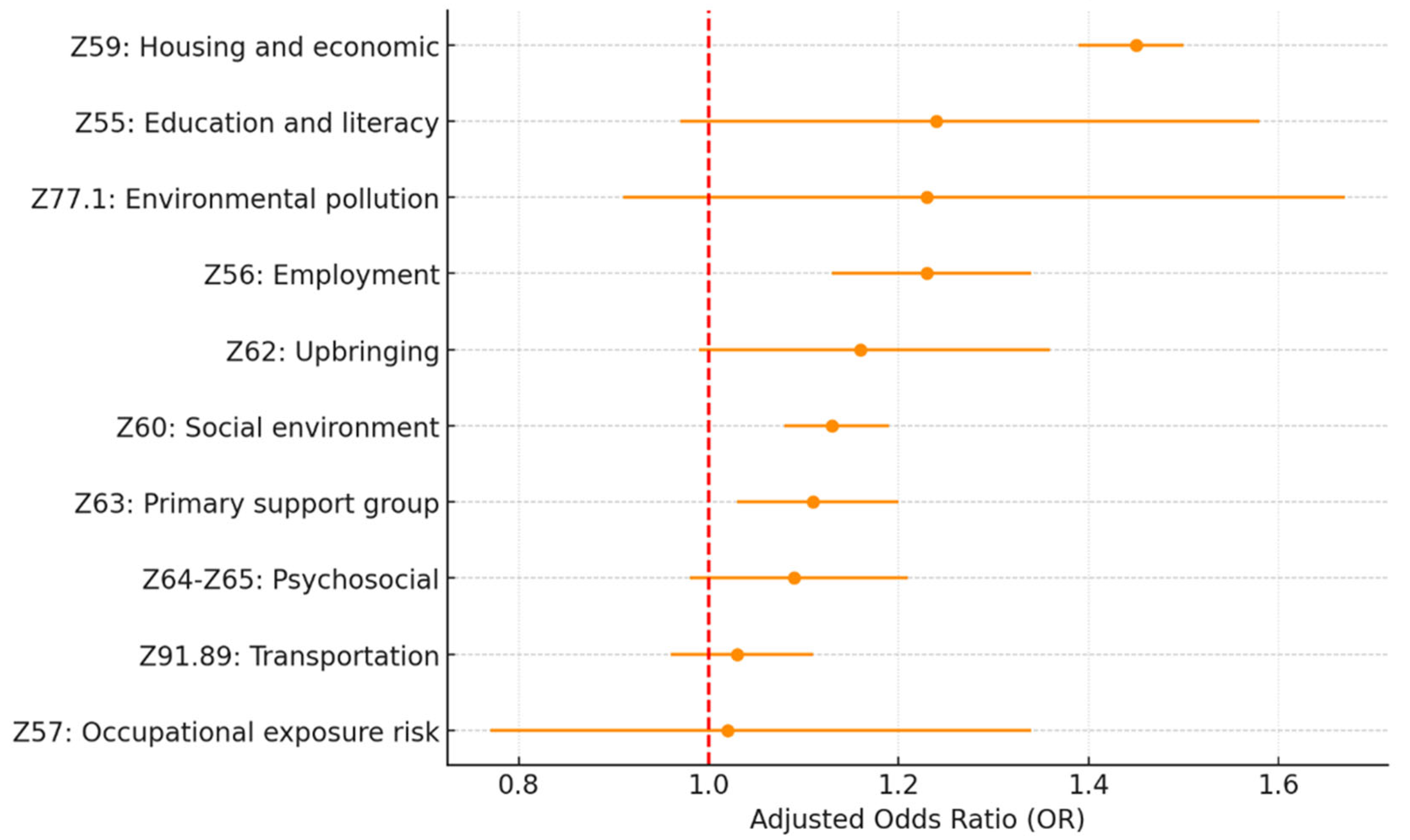
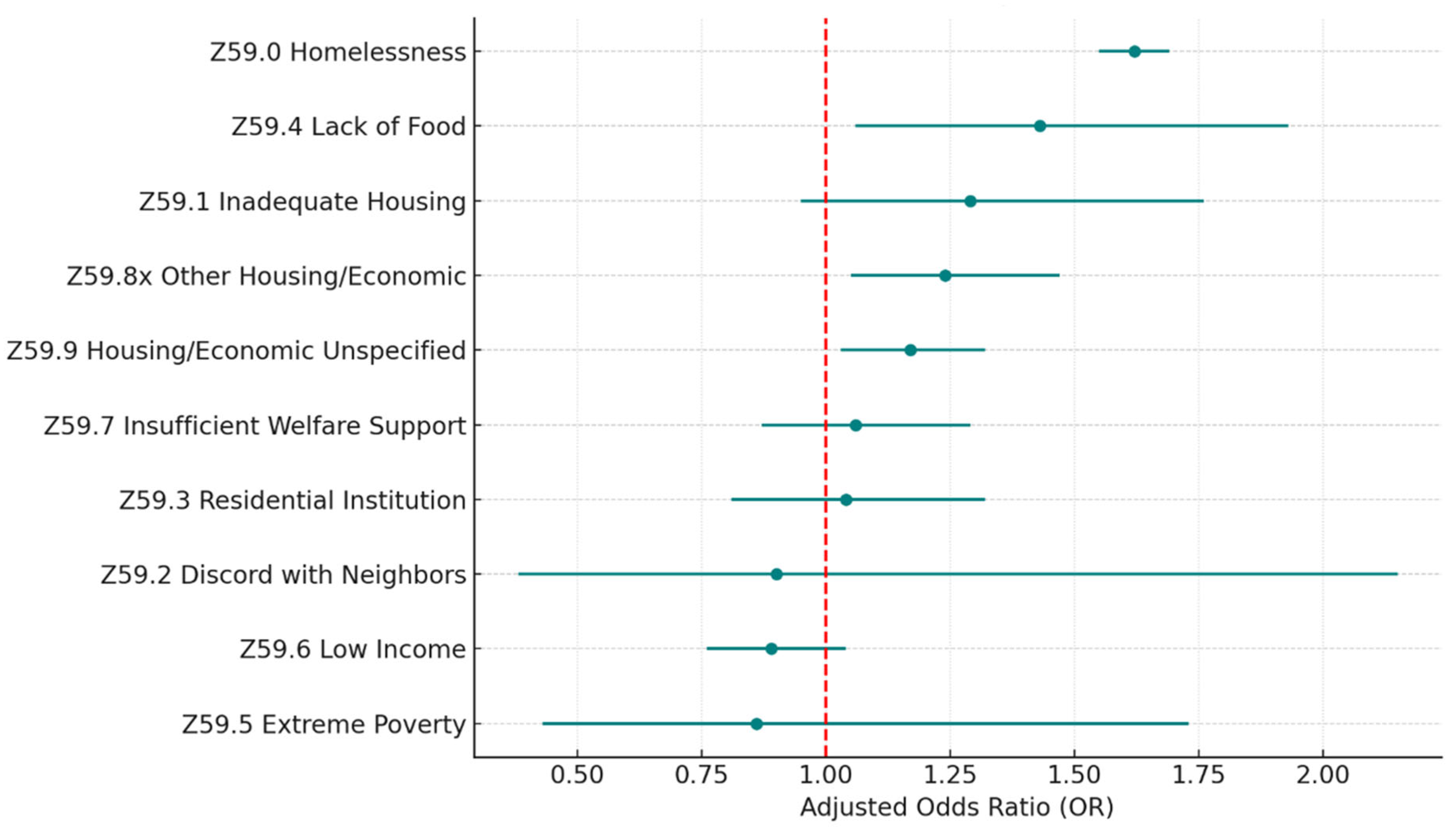
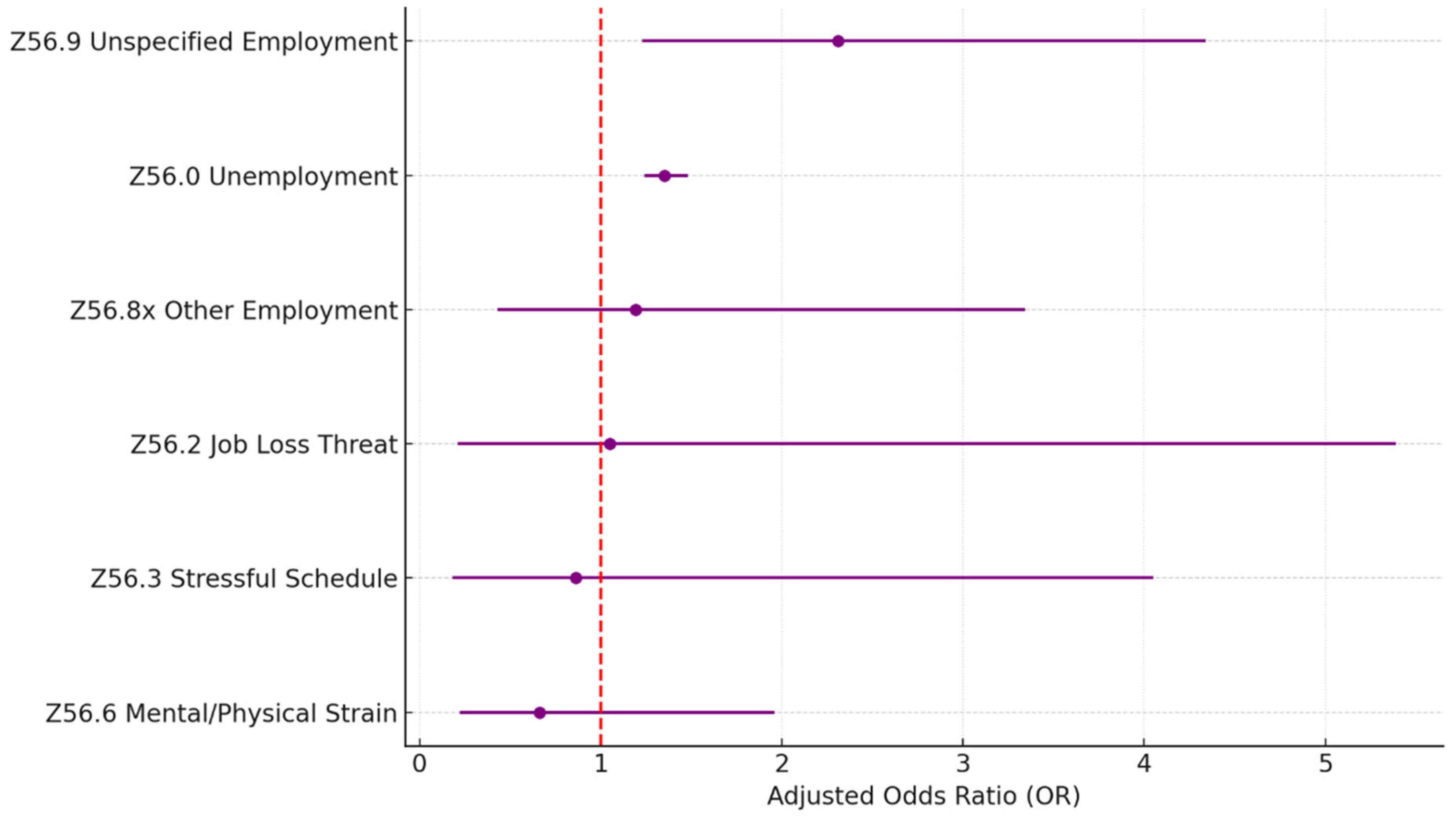
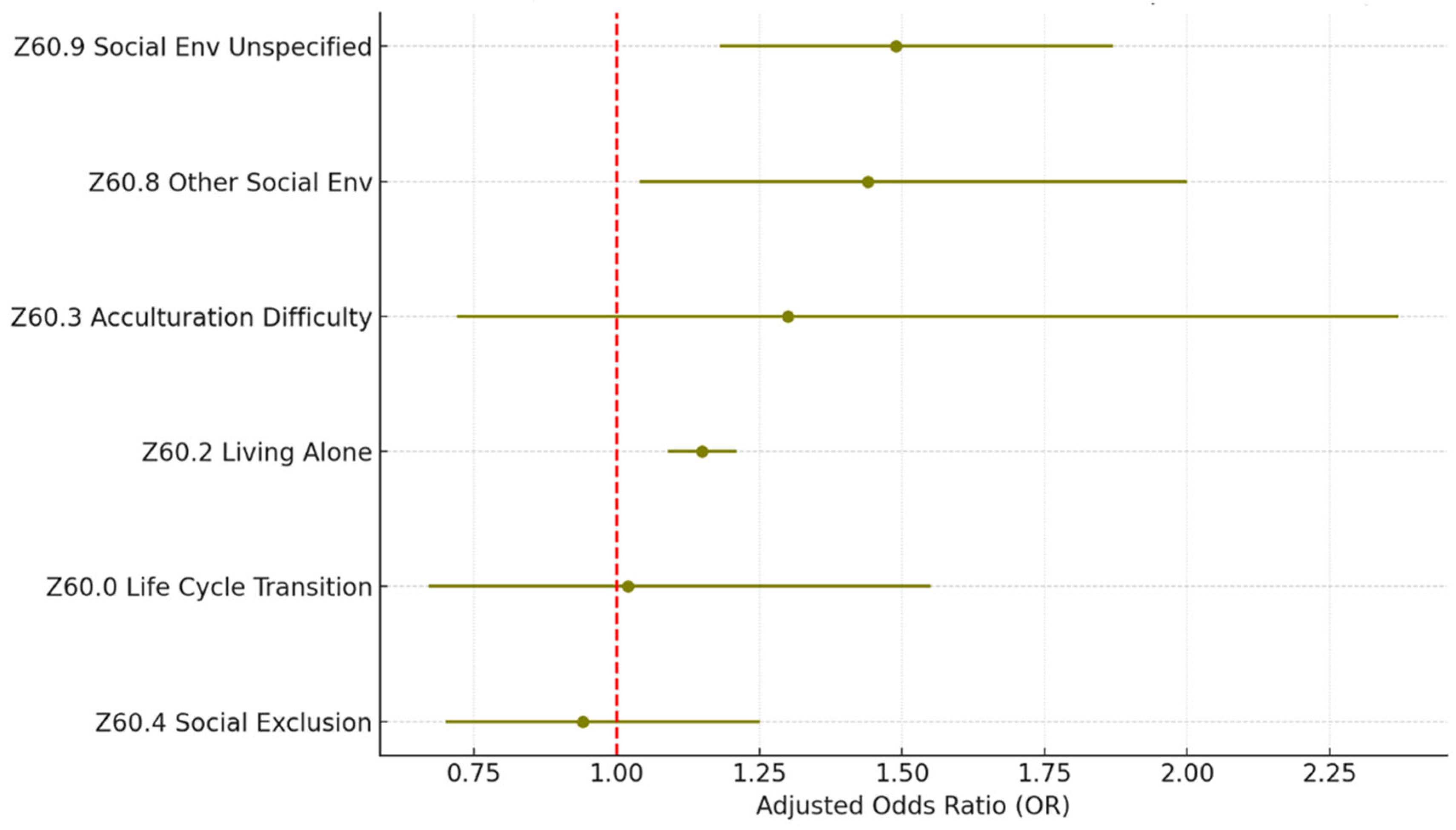
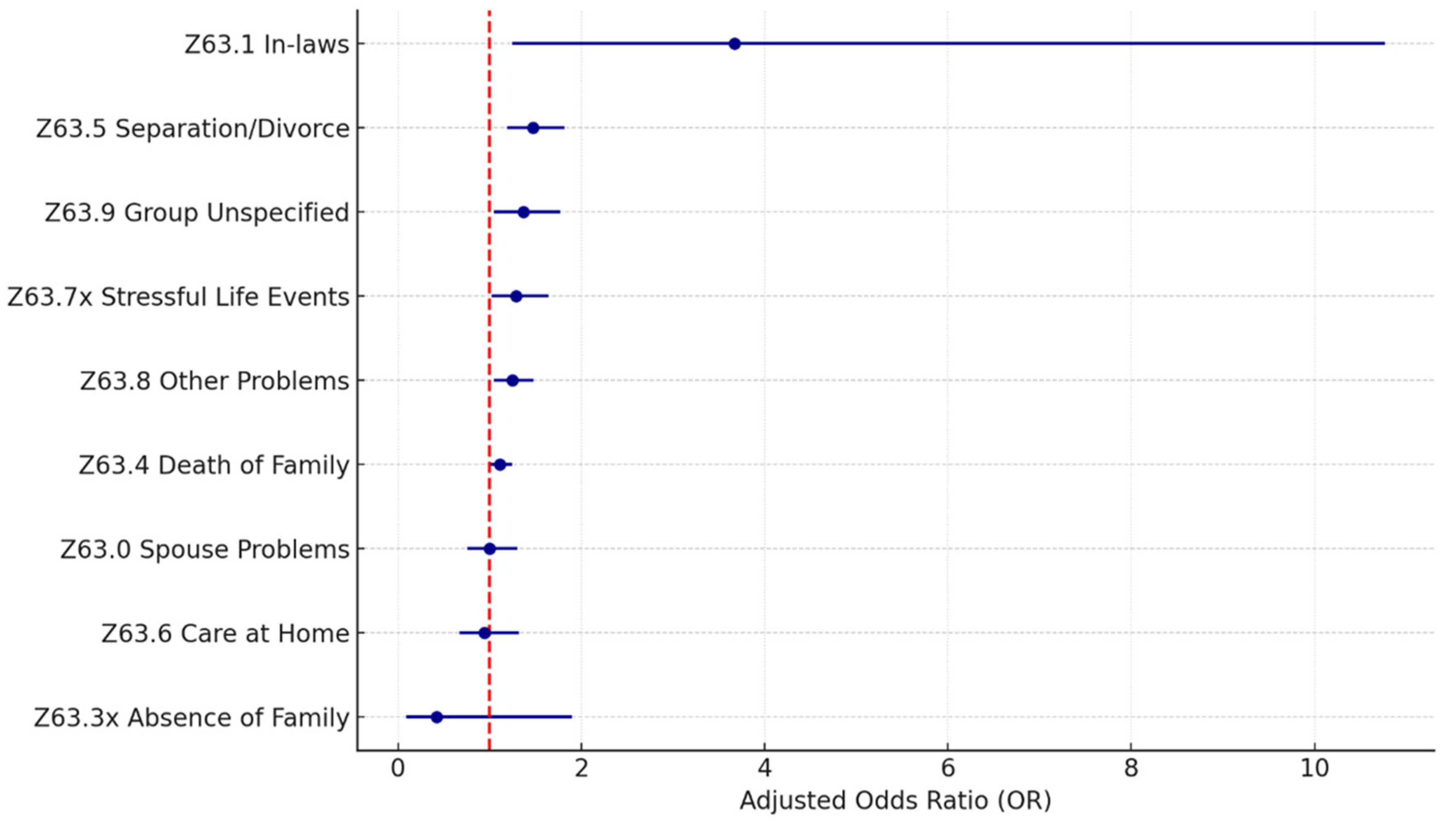
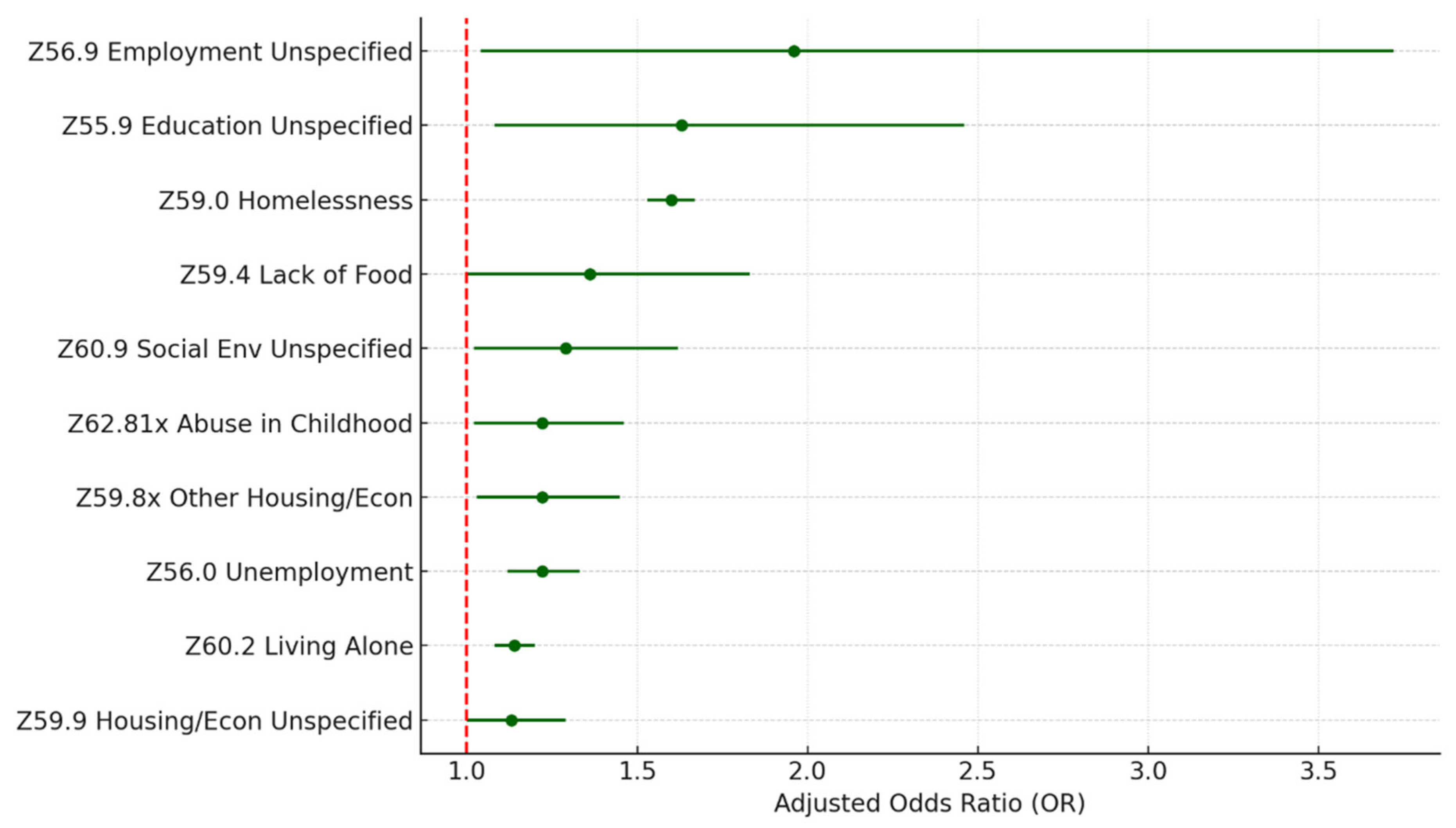
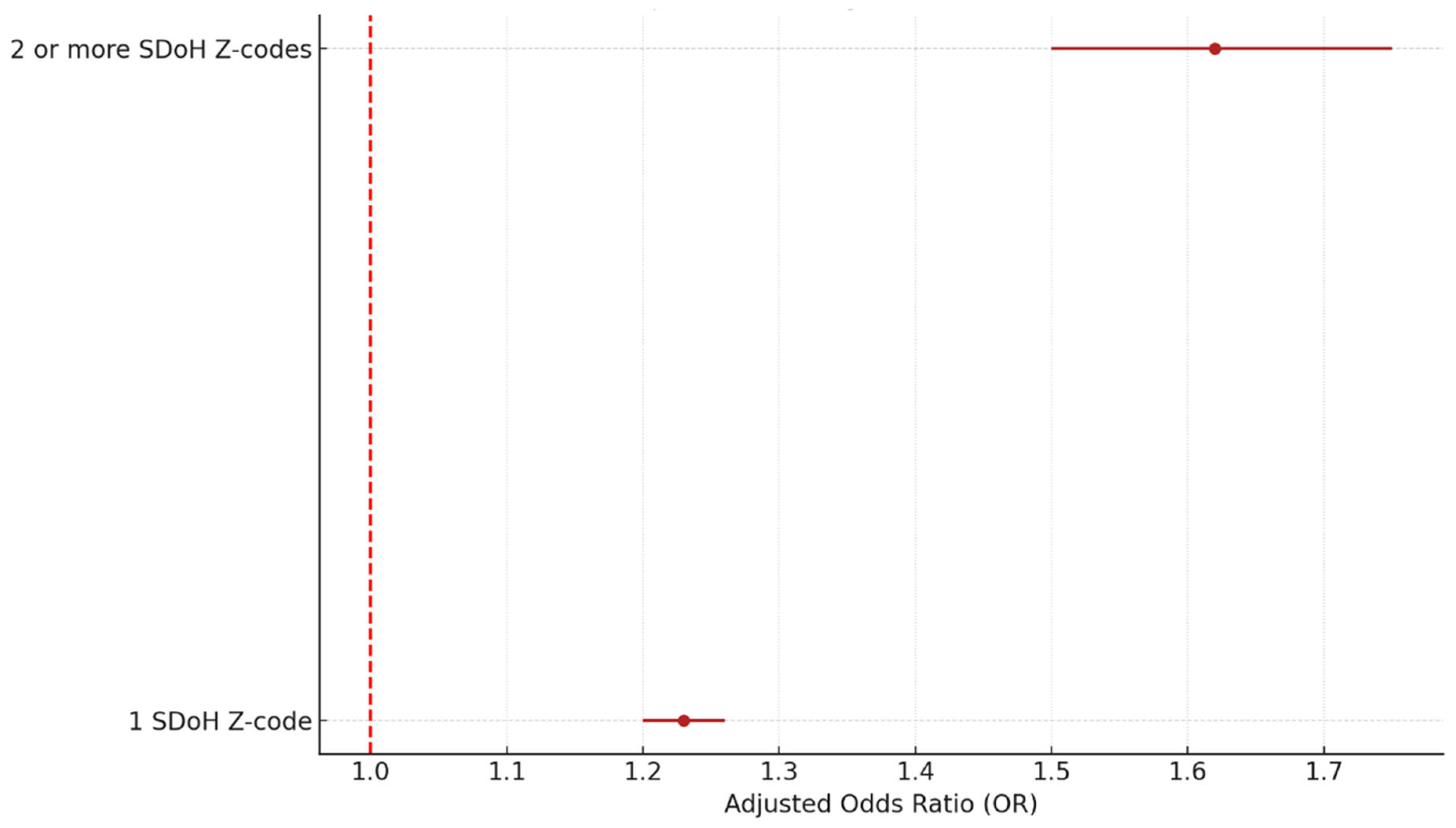
| Characteristics | Total N = 586,929 | No SDOH Z-Code N = 554,748 | Any SDOH Z-Codes N = 32,181 | p Value * |
|---|---|---|---|---|
| Age Group | <0.001 | |||
| <18 | 3135 (0.5%) | 2895 (0.5%) | 240 (0.7%) | |
| 18–34 | 9818 (1.7%) | 8836 (1.6%) | 982 (3.1%) | |
| 35–44 | 18,745 (3.2%) | 16,869 (3.0%) | 1876 (5.8%) | |
| 45–54 | 44,529 (7.6%) | 40,053 (7.2%) | 4476 (13.9%) | |
| 55–64 | 102,727 (17.5%) | 94,365 (17.0%) | 8362 (26.0%) | |
| 65+ | 407,975 (69.5%) | 391,730 (70.6%) | 16,245 (50.5%) | |
| Number of1-year previous HF hospitalizations | <0.001 | |||
| 0 | 441,124 (75.2%) | 420,818 (75.9%) | 20,306 (63.1%) | |
| 1 | 53,859 (9.2%) | 50,460 (9.1%) | 3399 (10.6%) | |
| 2+ | 91,946 (15.7%) | 83,470 (15.0%) | 8476 (26.3%) | |
| Charles Comorbidity Index (CCI) | 0.012 | |||
| 0–2 | 93,043 (15.9%) | 87,765 (15.8%) | 5278 (16.4%) | |
| 3–5 | 211,457 (36.0%) | 200,024 (36.1%) | 11,433 (35.5%) | |
| 6+ | 282,429 (48.1%) | 266,959 (48.1%) | 15,470 (48.1%) | |
| Gender | <0.001 | |||
| Female | 280,001 (47.7%) | 266,134 (48.0%) | 13,867 (43.1%) | |
| Male | 306,928 (52.3%) | 288,614 (52.0%) | 18,314 (56.9%) | |
| Previous HF diagnosis | <0.001 | |||
| No | 266,128 (45.3%) | 254,258 (45.8%) | 11,870 (36.9%) | |
| Yes | 320,801 (54.7%) | 300,490 (54.2%) | 20,311 (63.1%) | |
| Region | <0.001 | |||
| MIDWEST | 65,644 (11.2%) | 60,753 (11.0%) | 4891 (15.2%) | |
| NORTHEAST | 97,976 (16.7%) | 92,766 (16.7%) | 5210 (16.2%) | |
| SOUTH | 230,751 (39.3%) | 221,197 (39.9%) | 9554 (29.7%) | |
| WEST | 192,558 (32.8%) | 180,032 (32.5%) | 12,526 (38.9%) | |
| Payer Type | <0.001 | |||
| CASH | 1765 (0.3%) | 1632 (0.3%) | 133 (0.4%) | |
| COMMERCIAL | 222,770 (38.0%) | 208,270 (37.5%) | 14,500 (45.1%) | |
| MEDICAID | 20,723 (3.5%) | 18,357 (3.3%) | 2366 (7.4%) | |
| MEDICARE | 341,671 (58.2%) | 326,489 (58.9%) | 15,182 (47.2%) | |
| Hospital Location: | <0.001 | |||
| Rural | 50,546 (8.6%) | 47,333 (8.5%) | 3213 (10.0%) | |
| Urban | 536,383 (91.4%) | 507,415 (91.5%) | 28,968 (90.0%) | |
| Hospital Teaching Flag | <0.001 | |||
| No | 298,831 (50.9%) | 283,164 (51.0%) | 15,667 (48.7%) | |
| Unknown | 78,149 (13.3%) | 74,634 (13.5%) | 3515 (10.9%) | |
| Yes | 209,949 (35.8%) | 196,950 (35.5%) | 12,999 (40.4%) | |
| Hospital Bed Size | <0.001 | |||
| 1–99 beds | 24,495 (4.2%) | 23,036 (4.2%) | 1459 (4.5%) | |
| 100–199 beds | 92,844 (15.8%) | 87,399 (15.8%) | 5445 (16.9%) | |
| 200–299 beds | 105,955 (18.1%) | 99,893 (18.0%) | 6062 (18.8%) | |
| 300–499 beds | 174,764 (29.8%) | 165,042 (29.8%) | 9722 (30.2%) | |
| 500 or more beds | 188,871 (32.2%) | 179,378 (32.3%) | 9493 (29.5%) | |
| Index HF Hospitalization Year | <0.001 | |||
| 2019 | 201,638 (34.4%) | 192,469 (34.7%) | 9169 (28.5%) | |
| 2020 | 192,485 (32.8%) | 181,616 (32.7%) | 10,869 (33.8%) | |
| 2021 | 192,806 (32.8%) | 180,663 (32.6%) | 12,143 (37.7%) |
| Total (N = 586,929) | No 30-Day Readmission (N = 453,833) | All-Cause 30-Day Readmission (N = 133,096) | p Value | |
|---|---|---|---|---|
| Z55.xx: Education and literacy | 316 (0.05%) | 220 (0.05%) | 96 (0.07%) | 0.001 |
| Z56.xx: Employment | 2646 (0.45%) | 1822 (0.40%) | 824 (0.62%) | <0.001 |
| Z57.xx: Occupational exposure risk | 279 (0.05%) | 210 (0.05%) | 69 (0.05%) | 0.454 |
| Z59.xx: Housing and economic | 13,811 (2.35%) | 9444 (2.08%) | 4367 (3.28%) | <0.001 |
| Z60.xx: Social environment | 7954 (1.36%) | 5787 (1.28%) | 2167 (1.63%) | <0.001 |
| Z62.xx: Upbringing | 758 (0.13%) | 527 (0.12%) | 231 (0.17%) | <0.001 |
| Z63.xx: Primary support group | 3510 (0.60%) | 2550 (0.56%) | 960 (0.72%) | <0.001 |
| Z64.xx-Z65.xx: Psychosocial | 1737 (0.30%) | 1249 (0.28%) | 488 (0.37%) | <0.001 |
| Z77.1x: Environmental pollution | 215 (0.04%) | 155 (0.03%) | 60 (0.05%) | 0.080 |
| Z91.89: Transportation | 4398 (0.75%) | 3273 (0.72%) | 1125 (0.85%) | <0.001 |
| Individual SDoH Adjusted Odds Ratio | p Value | Full Model SDoH Adjusted Odds Ratio | p Value | |
|---|---|---|---|---|
| Z55.xx: Education and literacy | 1.38 (1.08, 1.77) | 0.01 | 1.24 (0.97, 1.58) | 0.09 |
| Z56.xx: Employment | 1.36 (1.25, 1.48) | 0.00 | 1.23 (1.13, 1.34) | 0.00 |
| Z57.xx: Occupational exposure risk | 1.03 (0.78, 1.36) | 0.82 | 1.02 (0.77, 1.34) | 0.89 |
| Z59.xx: Housing and economic | 1.48 (1.42, 1.53) | 0.00 | 1.45 (1.39, 1.50) | 0.00 |
| Z60.xx: Social environment | 1.16 (1.11, 1.22) | 0.00 | 1.13 (1.08, 1.19) | 0.00 |
| Z62.xx: Upbringing | 1.35 (1.15, 1.58) | 0.00 | 1.16 (0.99, 1.36) | 0.06 |
| Z63.xx: Primary support group | 1.20 (1.12, 1.30) | 0.00 | 1.11 (1.03, 1.20) | 0.01 |
| Z64.xx-Z65.xx: Psychosocial | 1.20 (1.08, 1.34) | 0.00 | 1.09 (0.98, 1.21) | 0.12 |
| Z77.1: Environmental pollution | 1.25 (0.92, 1.69) | 0.15 | 1.23 (0.91, 1.67) | 0.18 |
| Z91.89: Transportation | 1.04 (0.97, 1.11) | 0.29 | 1.03 (0.96, 1.11) | 0.37 |
| Log-Likelihood | −3.08 × 105 | |||
| LLR p-value | 0.000 | |||
| AUC | 0.6013 | |||
| N (%) | Subcodes Adjusted Odds Ratio | p Value | |
|---|---|---|---|
| Z59.0 Homelessness | 10,394 (75.3%) | 1.62 (1.55, 1.69) | 0.00 |
| Z59.9 Problem Related to Housing and Economic Circumstances Unspecified | 1227 (8.9%) | 1.17 (1.03, 1.32) | 0.02 |
| Z59.6 Low Income | 887 (6.4%) | 0.89 (0.76, 1.04) | 0.15 |
| Z59.8x Other Problems Related to Housing and Economic Circumstances | 680 (4.9%) | 1.24 (1.05, 1.47) | 0.01 |
| Z59.7 Insufficient Social Insurance and Welfare Support | 539 (3.9%) | 1.06 (0.87, 1.29) | 0.59 |
| Z59.3 Problems Related to Living in Residential Institution | 364 (2.6%) | 1.04 (0.81, 1.32) | 0.77 |
| Z59.4 Lack of Adequate Food | 200 (1.4%) | 1.43 (1.06, 1.93) | 0.02 |
| Z59.1 Inadequate Housing | 195 (1.4%) | 1.29 (0.95, 1.76) | 0.10 |
| Z59.5 Extreme Poverty | 45 (0.3%) | 0.86 (0.43, 1.73) | 0.67 |
| Z59.2 Discord with Neighbors Lodgers and Landlord | 29 (0.2%) | 0.90 (0.38, 2.15) | 0.82 |
| N (%) | Subcodes Adjusted Odds Ratio | p Value | |
|---|---|---|---|
| Z56.0 Unemployment Unspecified | 2552 (96.4%) | 1.35 (1.24, 1.48) | 0.00 |
| Z56.9 Unspecified Problems Related to Employment | 41 (1.5%) | 2.31 (1.23, 4.34) | 0.01 |
| Z56.6 Other Physical and Mental Strain Related to Work | 25 (0.9%) | 0.66 (0.22, 1.96) | 0.46 |
| Z56.8x Other Problems Related to Employment | 20 (0.8%) | 1.19 (0.43, 3.34) | 0.74 |
| Z56.3 Stressful Work Schedule | 11 (0.4%) | 0.86 (0.18, 4.05) | 0.85 |
| Z56.2 Threat of Job Loss | 8 (0.3%) | 1.05 (0.21, 5.39) | 0.95 |
| Z56.5 Uncongenial Work Environment | 1 (0.0%) | NA | NA |
| Z56.1 Change of Job | 0 (0.0%) | NA | NA |
| Z56.4 Discord with Boss and Workmates | 0 (0.0%) | NA | NA |
| N (%) | Subcodes Adjusted Odds Ratio | p Value | |
|---|---|---|---|
| Z60.2 Problems Related to Living Alone | 7042 (88.5%) | 1.15 (1.09, 1.21) | 0.00 |
| Z60.9 Problem Related to Social Environment Unspecified | 347 (4.4%) | 1.49 (1.18, 1.87) | 0.00 |
| Z60.4 Social Exclusion and Rejection | 271 (3.4%) | 0.94 (0.70, 1.25) | 0.66 |
| Z60.8 Other Problems Related to Social Environment | 171 (2.1%) | 1.44 (1.04, 2.00) | 0.03 |
| Z60.0 Problems of Adjustment to Life Cycle Transitions | 120 (1.5%) | 1.02 (0.67, 1.55) | 0.92 |
| Z60.3 Acculturation Difficulty | 53 (0.7%) | 1.30 (0.72, 2.37) | 0.38 |
| Z60.5 Target of Perceived Adverse Discrimination and Persecution | 2 (0.0%) | 2.94 (0.18, 47.89) | 0.45 |
| N (%) | Subcodes Adjusted Odds Ratio | p Value | |
|---|---|---|---|
| Z63.4 Disappearance and Death of Family Member | 1479 (42.1%) | 1.11 (0.98, 1.25) | 0.09 |
| Z63.8 Other Specified Problems Related to Primary Support Group | 676 (19.3%) | 1.25 (1.05, 1.48) | 0.01 |
| Z63.5 Disruption of Family by Separation and Divorce | 395 (11.3%) | 1.47 (1.19, 1.82) | 0.00 |
| Z63.7x Other Stressful Life Events Affecting Family and Household | 348 (9.9%) | 1.29 (1.02, 1.64) | 0.03 |
| Z63.0 Problems in Relationship with Spouse or Partner | 300 (8.5%) | 1.00 (0.76, 1.30) | 0.99 |
| Z63.9 Problem Related to Primary Support Group Unspecified | 280 (8.0%) | 1.37 (1.05, 1.77) | 0.02 |
| Z63.6 Dependent Relative Needing Care at Home | 200 (5.7%) | 0.94 (0.67, 1.32) | 0.72 |
| Z63.3x Absence of Family Member | 15 (0.4%) | 0.42 (0.09, 1.90) | 0.26 |
| Z63.1 Problems in Relationship with In-Laws | 14 (0.4%) | 3.67 (1.25, 10.77) | 0.02 |
| N (%) | Stepwise SDoH Subcodes Adjusted Odds Ratio | p Value | |
|---|---|---|---|
| Z55.9 Education Literacy Unspecified | 105 (0.02%) | 1.63 (1.08, 2.46) | 0.02 |
| Z56.0 Unemployment Unspecified | 2552 (0.43%) | 1.22 (1.12, 1.33) | 0.00 |
| Z56.9 Unspecified Problems Related to Employment | 41 (0.01%) | 1.96 (1.04, 3.72) | 0.04 |
| Z59.0 Homelessness | 10,394 (1.77%) | 1.60 (1.53, 1.67) | 0.00 |
| Z59.1 Inadequate Housing | 195 (0.03%) | 1.25 (0.92, 1.70) | 0.15 |
| Z59.4 Lack of Adequate Food | 200 (0.03%) | 1.36 (1.00, 1.83) | 0.05 |
| Z59.6 Low Income | 887 (0.15%) | 0.87 (0.74, 1.02) | 0.08 |
| Z59.8x Other Problems Related to Housing and Economic Circumstances | 680 (0.12%) | 1.22 (1.03, 1.45) | 0.02 |
| Z59.9 Problem Related to Housing and Economic Circumstances Unspecified | 1227 (0.21%) | 1.13 (1.00, 1.29) | 0.05 |
| Z60.2 Problems Related to Living Alone | 7042 (1.20%) | 1.14 (1.08, 1.20) | 0.00 |
| Z60.9 Problem Related to Social Environment Unspecified | 347 (0.06%) | 1.29 (1.02, 1.62) | 0.03 |
| Z62.81x Personal History of Abuse in Childhood | 603 (0.10%) | 1.22 (1.02, 1.46) | 0.03 |
| Z62.9 Problem Related to Upbringing Unspecified | 11 (0.00%) | 2.56 (0.77, 8.55) | 0.13 |
| Z63.1 Problems in Relationship with In-Laws | 14 (0.00%) | 3.56 (1.21, 10.43) | 0.02 |
| Z63.5 Disruption of Family by Separation and Divorce | 395 (0.07%) | 1.34 (1.08, 1.66) | 0.01 |
| Z63.7x Other Stressful Life Events Affecting Family and Household | 348 (0.06%) | 1.24 (0.98, 1.57) | 0.08 |
| Log-Likelihood | 3.076 × 105 | ||
| LLR p-value | 0.000 | ||
| AUC | 0.6016 | ||
| N | Adjusted Odds Ratio (95% CI) | p Value | |
|---|---|---|---|
| SDOH 1 | 29,308 | 1.23 (1.20, 1.26) | 0.00 |
| SDOH >= 2 | 2873 | 1.62 (1.50, 1.75) | 0.00 |
| Log-Likelihood | 3.077 × 105 | ||
| LLR p-value | 0.000 | ||
| AUC | 0.601 | ||
Disclaimer/Publisher’s Note: The statements, opinions and data contained in all publications are solely those of the individual author(s) and contributor(s) and not of MDPI and/or the editor(s). MDPI and/or the editor(s) disclaim responsibility for any injury to people or property resulting from any ideas, methods, instructions or products referred to in the content. |
© 2025 by the authors. Licensee MDPI, Basel, Switzerland. This article is an open access article distributed under the terms and conditions of the Creative Commons Attribution (CC BY) license (https://creativecommons.org/licenses/by/4.0/).
Share and Cite
Cai, Y.; Yanping, L.; Liu, Q. Social Determinants of Health and 30-Day Readmission for Heart Failure Patients in U.S. Hospitals: Evidence from ICD-10 Z-Code Data. Healthcare 2025, 13, 2102. https://doi.org/10.3390/healthcare13172102
Cai Y, Yanping L, Liu Q. Social Determinants of Health and 30-Day Readmission for Heart Failure Patients in U.S. Hospitals: Evidence from ICD-10 Z-Code Data. Healthcare. 2025; 13(17):2102. https://doi.org/10.3390/healthcare13172102
Chicago/Turabian StyleCai, Yong, Liu Yanping, and Qiang Liu. 2025. "Social Determinants of Health and 30-Day Readmission for Heart Failure Patients in U.S. Hospitals: Evidence from ICD-10 Z-Code Data" Healthcare 13, no. 17: 2102. https://doi.org/10.3390/healthcare13172102
APA StyleCai, Y., Yanping, L., & Liu, Q. (2025). Social Determinants of Health and 30-Day Readmission for Heart Failure Patients in U.S. Hospitals: Evidence from ICD-10 Z-Code Data. Healthcare, 13(17), 2102. https://doi.org/10.3390/healthcare13172102




